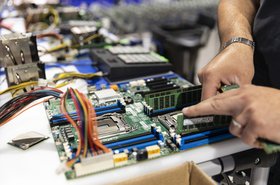Open19, the open source hardware project which LinkedIn launched in 2017, has moved to the Linux Foundation, under the direction of its founder Yuval Bachar.
The Open19 project began when LinkedIn developed its own simplified data center hardware including network switches, and spun up a system of rack designs and other open source hardware. After some uncertainty when LinkedIn was bought by Microsoft, the Open19 specifications are now being maintained by the Linux Foundation, where Bachar has moved to a part-time role as a Fellow.
A new generation of the Open19 specifications for Edge and data center hardware should be available mid-year 2021.
For breaking data center news, features, and opinions, subscribe to DCD's newsletter
Open for business
"Open19 began in 2016," Bachar told DCD. "Five years on, the power per server is changing, and the bandwidth of the network is increasing. We're taking it two notches up, to a place with higher power per server. We'll enable new technology for servers with core processors or accelerators, and maintain backward compatibility, so you will be able to plug in old servers to the new system."
The new specifications will keep to the Open19 principles, with no cabling system and high reliability, while extending applicability to the Edge, he said.
Sitting within the Linux Foundation, Open19 will be able to integrate with software projects for tasks like management and provisioning, Bachar said: "We’re going to start introducing more and more software packages. It will be easy for us to integrate software functions into Open19."
He hopes to revitalize the Open19 community, with future events and eventual face-to-face meetings: "Like the original Open19, it's a community effort, not the big guys saying 'Go build it'. We're rebuilding the community, adding new members and renewing older members. The goal is to extend this to everybody. No matter who you are you can drop it in place. You don’t need 20 people to develop software."
Open roots
Open19 began with a similar focus to the Open Compute Project (OCP), which Facebook launched to share and promote its cost-saving data center hardware designs. However, while OCP made radical changes such as proposing racks that took 21-inch wide hardware, Open19 kept the traditional 19 inch rack, but created a standardized system of cages holding standardized blades with standard power distribution. Its specifications include a brick cage, server brick form factor, power shelf and blind-mate power and data connectors.
When Open19 launched, Yuval Bachar, then principal engineer at LinkedIn, claimed its approach created great hardware savings: ”We wanted to create a cost reduction of 50 percent in common elements like the PDU, power and the rack itself. We actually achieved 65 percent.”
When Microsoft bought LinkedIn for $26 billion in 2016, Open19's role became less clear, as Microsoft backed OCP, and LinkedIn data centers are all being moved to Microsoft Azure. After some enthusiastic Open19 summit meetings, last year's event was canceled due to the Covid-19 pandemic.
However, Open19 has some supporters, including Equinix, which is adopting Open19 hardware for the bare metal as a service offering of its Packet acquisition. Open19 has been focusing on Edge as well as bare metal data center services. Cisco has also adopted Open19 technologies.
Bachar, who had been with Microsoft, has just left that company. He will be an Open19 Fellow at the Linux Foundation, leading the project, and is also working on his own stealth startup.
"As the open hardware project of The Linux Foundation, the Open19 Project is dedicated to creating solutions that help digital businesses take advantage of specialized infrastructure," said Zachary Smith, Open19 Foundation chairperson and managing director of Equinix Metal. "We are excited to join The Linux Foundation to solve the challenges facing modern data centers with collaborative, open, community-led innovation."
Although the Linux Foundation is best known for its support of software, including the Linux operating system, it has already had some involvement with open source hardware. The OpenPower Foundation, which manages the instruction set of the Power processor architecture, originally created by IBM, joined the Linux Foundation in 2019. The Foundation also manages DPDK, OpenBMC, and RISC-V projects; the LF Edge, and Cloud Native Computing Foundations; and has incubated projects such as Equinix's bare metal provisioning engine Tinkerbell.




